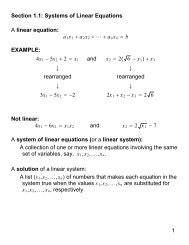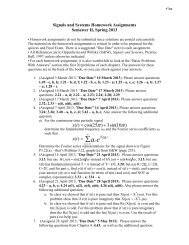Course Notes on Formal Languages and Compilers
Course Notes on Formal Languages and Compilers
Course Notes on Formal Languages and Compilers
Create successful ePaper yourself
Turn your PDF publications into a flip-book with our unique Google optimized e-Paper software.
10. PROGRAMMING LANGUAGE IMPLEMENTATION ISSUES<br />
51<br />
5<br />
10<br />
15<br />
20<br />
25<br />
30<br />
35<br />
A high level rogramming language has a hierarchic structure for statements<br />
expressi<strong>on</strong>s <strong>and</strong> definiti<strong>on</strong>s of functi<strong>on</strong>s, procedures, data <strong>and</strong> their types.<br />
Assembly language has a sequential structure (except for expressi<strong>on</strong>s) <strong>and</strong><br />
does not support a large variety of data types. Machine language is<br />
completely sequential in structure <strong>and</strong> has no c<strong>on</strong>cept at all of data type.<br />
There is therefore a large gap between a high level language <strong>and</strong> machine<br />
or <strong>and</strong> the main problem to be h<strong>and</strong>led is this large gap. It is for this reas<strong>on</strong><br />
that there are many phases in compilati<strong>on</strong> <strong>and</strong> interpretati<strong>on</strong>, where each<br />
phase h<strong>and</strong>les a part of the problem. The multiphase design makes also it<br />
easier to transfer the compiler to another machine. This is because the<br />
code generati<strong>on</strong> phase <strong>and</strong> the interpretati<strong>on</strong> phase are the <strong>on</strong>ly really<br />
machine dependent phases in the compiler.<br />
Let us now give examples of different programming language features,<br />
associated problems <strong>and</strong> some soluti<strong>on</strong>s.<br />
Code generati<strong>on</strong> or interpretati<strong>on</strong> - Associating properties with names<br />
Recall first the distincti<strong>on</strong> between identifier <strong>and</strong> name, that is names are<br />
unique but identifiers can have multiple definiti<strong>on</strong>s. Certain languages (such<br />
as Fortran IV) allow determining all the properties of a name at compile<br />
turns e.g. type of data, its size, <strong>and</strong> its absolute run time address. Other<br />
languages such a Pascal, need the absolute address to be determined at<br />
run time even though sizes are all known. At compile time, relative<br />
addresses are known e.g. relative to top of a stack.<br />
Other languages such as ADA, the size of data is not known <strong>and</strong> even this<br />
needs to be determined at run time e.g. <strong>on</strong> block entry. In languages such<br />
as LISP <strong>and</strong> PROLOG the type may <strong>on</strong>ly be known at run time. In view of<br />
these approaches to languages, different implementati<strong>on</strong>s are used. Code<br />
generati<strong>on</strong> can be used when the types of the data are known at compile<br />
time but is much harder or impossible to use when the data types are<br />
known at run time, <strong>and</strong> interpretati<strong>on</strong> is a simpler soluti<strong>on</strong> in this case.<br />
Type declarati<strong>on</strong>s <strong>and</strong> checking<br />
Here are three possibilities for programming languages.<br />
40<br />
45<br />
Str<strong>on</strong>gly typed language: Type declarati<strong>on</strong>s <strong>and</strong> compile time type<br />
checking. e.g. Pascal, ADA<br />
Weakly typed language: Type declarati<strong>on</strong>s but no type checking.<br />
e.g. assembly language, C.<br />
Utyped language: No type declarati<strong>on</strong>s but run time type checking.<br />
e.g. LISP, PROLOG












